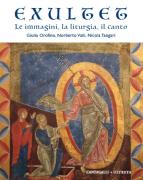Exultet

Le immagini, la liturgia, il canto
The term Exultet corresponds to the first word of the liturgical song which, from the pulpit, is intoned by the deacon during the ceremony on the night of Holy Saturday. In full, the same term also came to indicate the scrolls on which the text of the hymn was transcribed and illustrated several times between the 10th and 14th centuries, according to a practice attested almost exclusively in southern Italy. Only about twenty examples of this production have survived. The structure of these codes is completely particular: the scrolls were placed on the ambo and unrolled as the singing progressed; the miniatures illustrating them were placed in the opposite direction to the musical score, so that the public could admire them on the front of the ambo. If the monumental catalog of the exhibition held in 1994 remains an essential point of reference for scholars, this volume, enriched by extensive iconography and exhaustive explanations, intends to present this important chapter in the history of medieval art to a wider audience. The work is divided into three essays - on the iconography, liturgy and music of the Exultet - and is enriched by substantial photographic documentation, largely created specifically for the occasion.